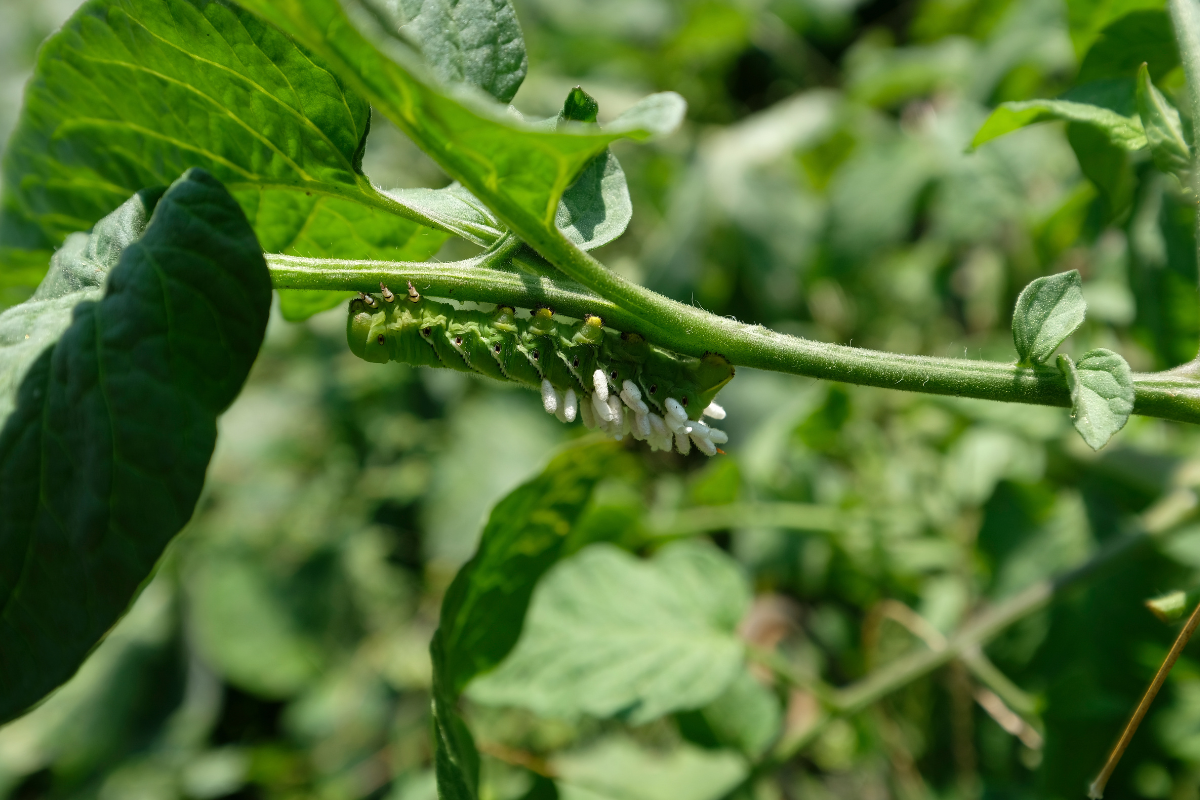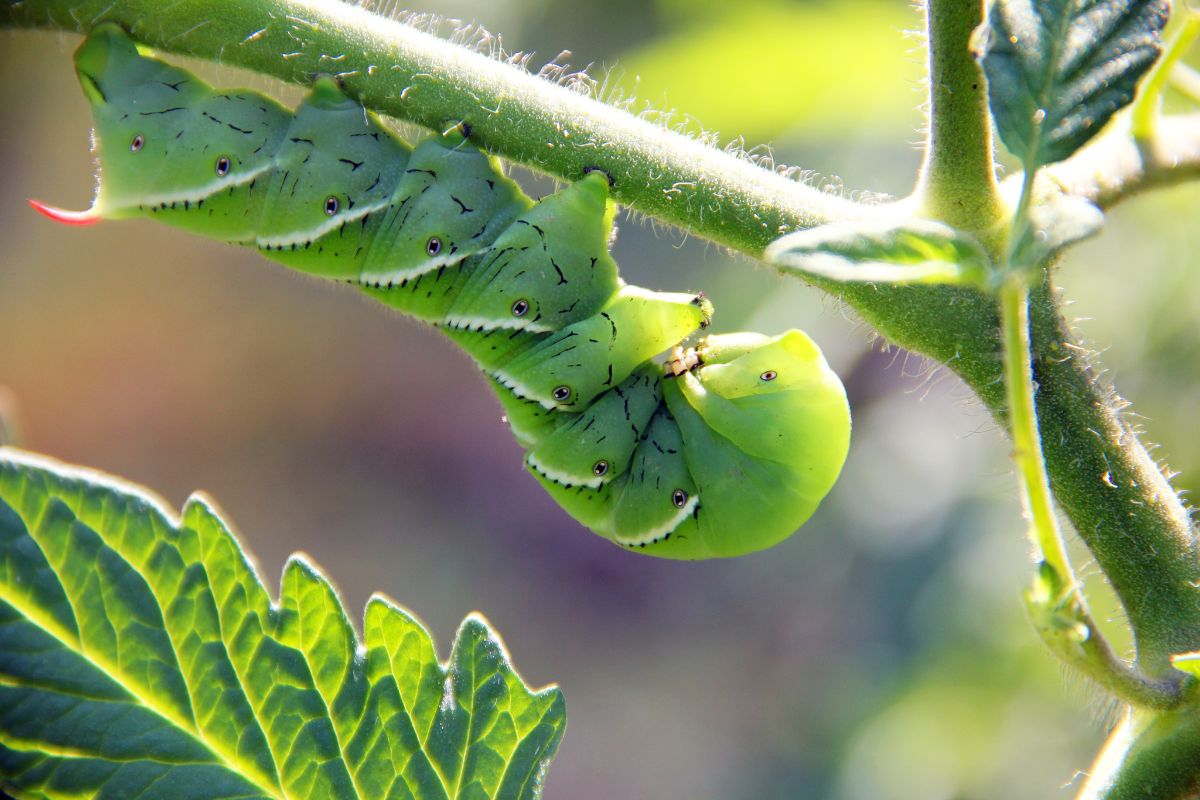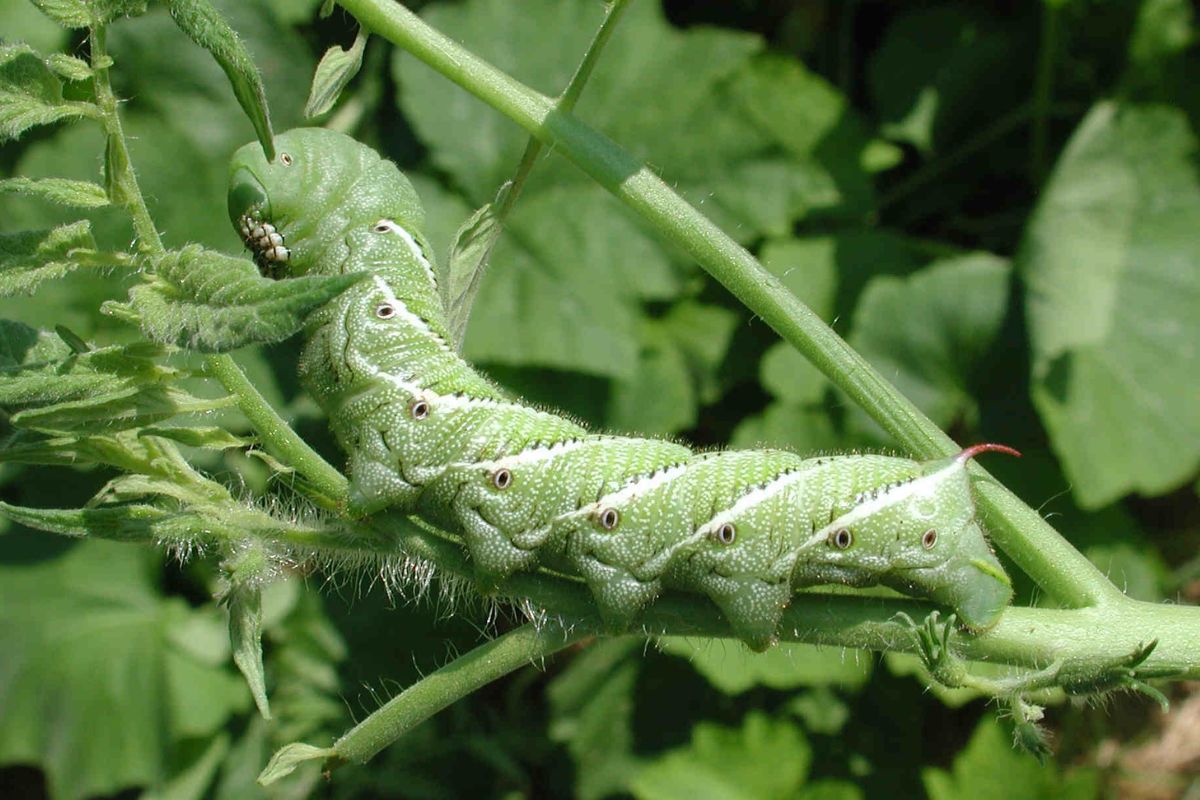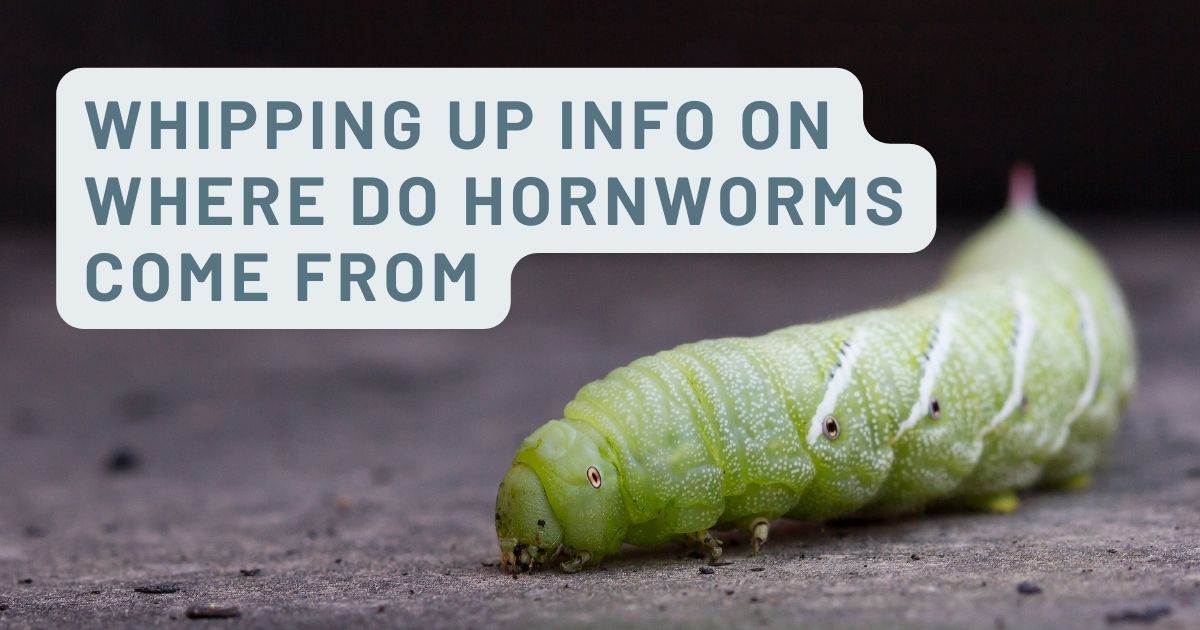Watching your tomatoes grow healthy is all fun until you come across weird holes from hornworms. But where do hornworms come from? Well, this is a question that many farmers leave unanswered.
If this is you, don’t fret! We have all the answers to eliminate these ferocious critters and make your plants whole again. So, if you are a victim, here’s how to identify, prevent and get rid of them.

What is a Hornworm?
A hornworm is a huge caterpillar with a horn-like tail that loves plants such as tomatoes. Hornworms come in two types; tomato and tobacco hornworms. Also, they grow into adults, and their physical appearance changes.
Adult tomato hornworms with large bodies are known as sphinx or hummingbird moths. Apart from tomatoes, they love clinging to eggplant, potatoes, peppers, and tobacco. But the most surprising part is that they feed from dusk until dawn.
The Tomato Hornworm Life Cycle
The tomato hornworm life cycle revolves around four stages: egg, caterpillar or larva, pupa, and adult moth. Tomato hornworms pupate over the winter months and emerge as adult moths in spring. After mating, females lay oval, smooth, light green eggs on the bottom and top leaf surfaces.
The tomato hornworm eggs have a pale green to greenish-yellow hue and are smaller than 0.039 inches (0.01 centimeters). The caterpillars start eating after they molt and stay full for three to four weeks. As a result, they begin to outgrow their exoskeleton, also called their hard “skin,” as they grow and molt to build a new one.
Caterpillars or tomato hornworms go through five instars (an interval between each molting process) before becoming pupae. The caterpillar’s body separates and then reforms into an adult during pupation. The moths are nocturnal and only fly at night after emerging from their puparium.
After emerging from their puparium, the nocturnal moths fly around, eat floral nectar, and look for mates. After mating, it lays eggs on a nightshade plant that the larvae consume. After this, the tomato hornworm life cycle repeats itself.
What Do Hornworms Turn Into?
As mentioned earlier, there are various types of hornworms, but tomato and tobacco hornworms are common in gardens. Sometimes, gardeners refer to a tomato caterpillar as a hawk and hummingbird moth.
But what do hornworms turn into? The female moth deposits eggs on leaves that hatch into larvae or caterpillars. The caterpillar develops into pupae, then change into lovely moths with wings. In simple terms, hornworms are merely the hawk moth caterpillar stage.
What Do They Look Like?
Hornworms are stunning; enormous hornworms are caterpillars. Young hornworms that have just hatched are unmarked, yellow to white. Their bodies change to green as they molt and grow, and they also get V-shaped patterns on either side and a pointed tail resembling a horn as they mature.
Caterpillars can grow up to 4 inches (10 centimeters) in length when fully developed. The V-shaped markings on the sides of the bodies of the two species are different. In tomato hornworms, they are yellow-white, but in tobacco hornworms, they are white-black diagonal lines.
In addition, tomato hornworms have a sharp black tail on the terminal segment of their bodies, whereas tobacco hornworms have a brown or reddish one. Large and sturdy in build, adult moths have a 4 to 5-inch (10 to 13-centimeters) wingspan. Still, in appearance, they have yellow patches on the sides of their bodies and are gray-brown.
Where Do Hornworms Come From?
Where do hornworms come from? This is a question that many farmers ask themselves. For example, the giant Sphynx moth’s caterpillar is a tomato hornworm (sometimes called a hummingbird moth). The moth deposits an egg, and the hornworm caterpillar consumes until it reaches around 4 inches (10 centimeters).
The caterpillar then buries itself in the ground to pupate. On tomato plants, the hornworms are well concealed. The leafless stems make it easy to see where they have eaten, and you may frequently find them by their waste.
Picking these green worms off makes it simple to manage bacteria in the soil. Both tobacco and tomato hornworms consume tomato leaves. However, tobacco hornworms have light-colored slashes on the side, whereas tomato hornworms have light-colored V marks.
Large grayish-brown speckled moths that lay eggs produce tomato hornworms. In the summer, these moths lay eggs on their host plant (the tomato). Pupae of tomato hornworms flourish in the winter and emerge as brown moths in the spring.
The Damage That They Cause
When you see signs of tomato hornworm, don’t hesitate to take immediate measures. This is a vital aspect because they can cause damage. When a hornworm infests a tomato fruit, it will start eating the tomatoes after removing the leaves from the tomato plant. First, however, you need to notice them since they easily blend with the leaves.
Hornworms do not eat holes in the tomatoes as other worms do. Instead, these caterpillars damage the outer part. The big, open scars they leave behind on the fruit when they feed make the tomatoes inedible.
Hornworms can quickly attack several ripe and unripe tomatoes since they eat them. They produce visible droppings that are either dark green or black as they consume. Nonetheless, adult hornworms can kill multiple leaves in addition to the fruit. The degree of defoliation rises as they get bigger.

How to Get Rid of Hornworms
Now that you know how to identify tomato hornworm damage, it’s time to smash these creatures out of your precious garden. First, however, there’s no need to kill them. But how to get rid of hornworms? You can remove them by applying the following safe practices.
Handpicking
Due to its size, handpicking is the most common method of hornworm eradication in gardens. This is the most effective and safe means of managing them. Additionally, they are easy to find because of their large size. You can get rid of them by taking them out of the plant and throwing them into soapy water.
Apply Natural Pesticides
Second on the list is applying natural pesticides. Use the least harmful, short-lived natural pesticide to achieve control if numbers are high, and then release predatory insects to maintain control.
You can also treat with an organic insecticide if pest populations get out of hand. For better results, apply on the undersides of leaves and deep within the plant, where insects hide before excess defoliation.
Till the Soil
Roto-tilling the soil after harvest eliminates pupae that have overwintered there. Due to their size and shallow soil, pupae are particularly successful in this way. According to research, regular garden tilling leads to destruction by 90 percent.
Crop Rotation
Another natural strategy to get rid of hornworms in the garden is crop rotation. It can be a good approach to eliminate them and reduce the number of pupae that will eventually mature into egg-laying moths in the soil.
Companion Planting
Besides tilling and applying natural insecticides, consider companion planting, a natural way to eliminate tomato hornworms. For example, you can use plants such as basil. Your tomatoes will have a nicer taste when basil is growing nearby. Moreover, basil deters hornworms from these plants.
Should I Kill a Tomato Hornworm?
Should I kill a tomato hornworm? Never kill a tomato hornworm. The best method for eliminating these repulsive green monsters is handpicking. Gloves are ideal when dealing with disgusting juicy caterpillars because they frequently have a death hold on the foliage and are hard to remove.
Alternatively, give them to the chickens as a tasty treat. But if you notice anything on the caterpillar that resembles white rice, don’t! The entire process is courtesy of mother nature.
Where Do They Go During the Day?
Where do tomato hornworms go during the day? When they are out in the open, tomato hornworms are pretty simple to identify. They crawl around in search of juicy stems and leaves, as opposed to the soil or red tomato. But during the day, hornworms seem to vanish.
These bothersome critters spend the day on your tomato plant, neatly blending in with the surrounding foliage thanks to their similar-colored bodies. Hornworms use it as a survival technique so predators won’t see them and can keep eating through the night unbothered.
Additionally, tomato hornworms conceal themselves inside the plants and beneath leaves during the daytime. Even if you can’t see them directly, you can look for other indications that hornworms have been eating in your tomato garden, such as black, barrel-shaped grubs.
How Big Can They Get?
How big can hornworms get? Hornworms grow up to 5 inches (13 centimeters) long, which can be shocking to discover at first. However, when they are still caterpillars or larvae, they cause the most harm. They have a horn-like protrusion from their back and a light green color with white and black markings.
Appearance, Characteristics, and Breeding Habits
As mentioned earlier, tomato hornworms can either be large or small. Small tomato hornworms have no markings and range in color from yellow to white. On each side of the large caterpillars, eight white V-shaped markings appear. When you look closely, you’ll notice a black horn-like structure on the last abdominal segment of tomato hornworms.
Up to six weeks of feeding, larvae produce cocoons. After that, they spend two to three weeks underneath; if the temperatures are too low, overwintering lasts longer. Finally, in the spring, moths lay their eggs once more, but in warmer climates, there could be more than one generation per year.
How to Prevent a Hornworm Infestation
Tomato hornworms can be a nightmare. But you can save yourself from the headache by preventing the occurrence. There are many ways to prevent hornworm infestation. Below are the major and effective natural methods.
Use Companion Plants
Topping the list of the best and most natural ways to prevent hornworms is using companion plants. Many tomato companion plants, such as basil, dill, and marigold, are essential in separating hornworms. Infant hornworms cannot tolerate them. Therefore, Lure them away with basil, marigolds, or dill to have a bumper harvest.
Use Insecticidal Soap
Another method is using insecticidal soap. This is a less toxic soap that can help put hornworms away. So, Apply insecticidal soap to plants to kill smaller worms.
Handpicking
Typically, removing hornworms by hand is the safest method of all. However, it doesn’t use any chemicals or harm them. Remove them bit by bit, and remember to use protective gloves. After removing hornworms by hand, crush the pests or place them in soapy water.
Consider Parasitic Wasps
Another effective method is using parasitic wasps. Suppose you are wondering how they are helpful; here’s the thing. Parasitic wasps lay their eggs on the bodies of other arthropods, causing the death of these hosts.
It is best to leave the hornworms alone and allow the wasps to complete their life cycle because they will temporarily continue to eat before dying. Alternatively, take infected hornworms out of your garden and dispose of them. In this manner, the hornworm will stop destroying your crops, whereas the wasps will continue to do their job.
Tilling
Last but not least, till the soil. Tilling is essential since turning the soil kills the hornworms. For better results, practice regular tilling. Also, do this from the beginning and end of each season to kill 90% of hornworm larvae.
Tomato Hornworms vs. Tobacco Hornworms
The tomato hornworm, a big caterpillar, and the tobacco hornworm are closely related. You should notice the differences due to their resemblance when you look randomly. On the contrary, the two counterparts are not the same. They have some features that create huge distinctions.
Because of their sizes, both are frequently kept as pets by kids since they fail to recognize the differences. In simple terms, tobacco hornworms have a red horn and white stripes with black edges.
Tomato hornworms have v-shaped markings and either a blue or a black horn. Furthermore, there are variations in the patches on the abdomen. For example, the tomato hornworm only has five orange spots, compared to the tobacco hornworm, with six.

Summary
Hornworms are ferocious creatures that love tomato plants. They like hiding underneath the leaves, and this can make it hard to identify. When they attack, they invade a good percentage of the leaf. However, be on the lookout since they can cause massive destruction.
There are many ways of controlling and preventing these green critters. On the contrary, one mistake you should avoid at all costs is not to kill them, and if you choose to pluck by hand, use a protective glove. In the end, you’ll have healthy tomatoes, thus a bumper harvest.
